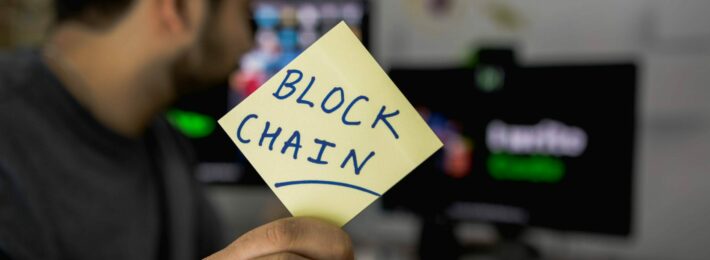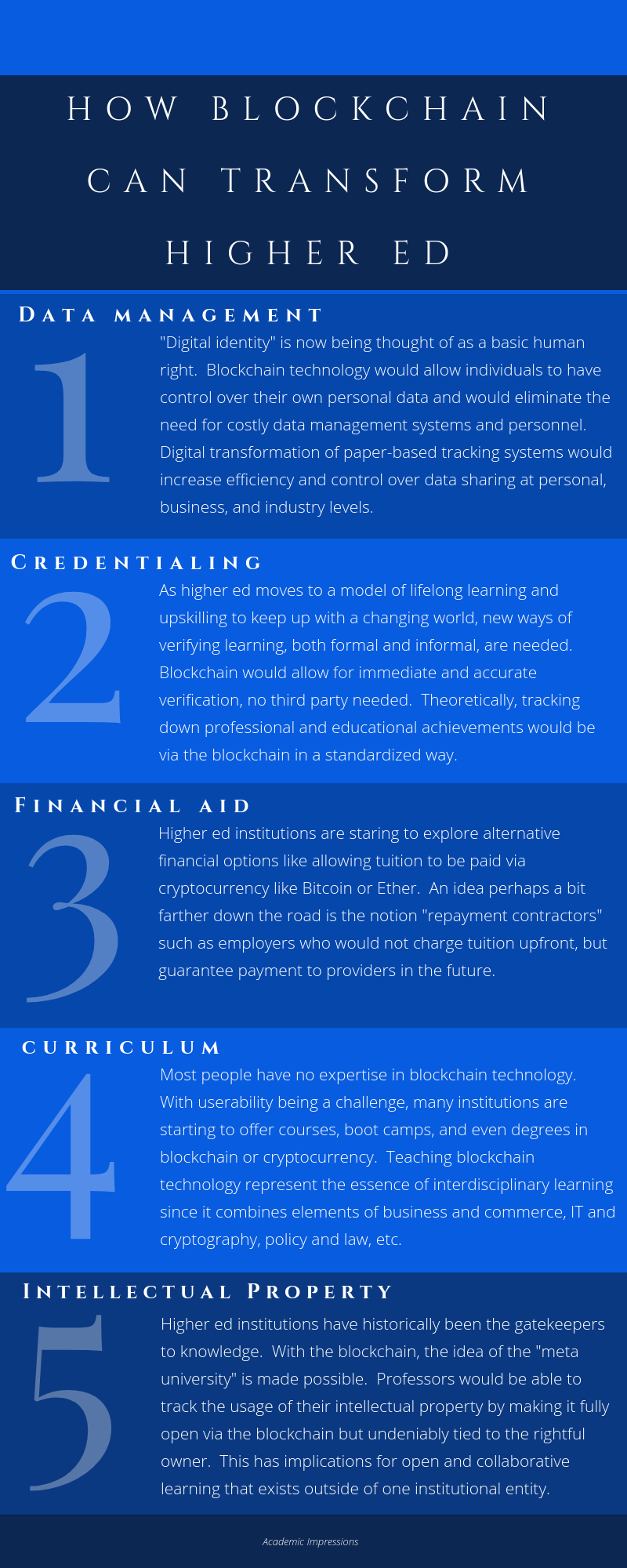
What is blockchain? As academic leaders, you want to stay on top of what’s coming next. And the blockchain could transform how colleges and universities operate in 5 critical ways.
What is the Blockchain?
The blockchain has been described as the new internet, the next generation of data and information. As a digital ledger that allows data to be dispersed across different users and user systems via cryptography, the blockchain allows for “trustless commerce in a trusted way,” according to one leading blockchain expert. That means you do not have to know the person on the other end of a transaction in order to know the transaction is secure and permanent. The technology takes care of that for you.
Most people who have heard about the blockchain know of it because they’ve heard of cryptocurrency, such as Bitcoin or Ether. Blockchain is the technology that enables cryptocurrencies, but it has potential uses far beyond just Bitcoin.
Leading expert Michael L. Mathews, vice president of innovation and technology at Oral Roberts University, suggests that the basic concept of blockchain technology has already been proven by the US Library of Congress’ use of MARC codes. These codes ensure that each item exists as only one entity and that there is only one copy that can be used at a time.
Here is how the technology works. A smart contract that involves complex algorithms is created and agreed upon by all users in a network. This contract is also known as a node, and it is used to place orders or data transitions. Users in a node are charged what is called a gas fee. All paying computers within a node are set up to handle blockchain transactions. For instance, when an institution assigns a student a blockchain diploma, the institution pays a fee and write a transaction that is recorded on the digital ledger. All computers in the node must record and verify the transaction, which adds a “block” to the “chain” of previous transactions. In this way, transactions are fully transparent, permanent, and distributed.
All computers in the network agree that a transaction is good via what is known as consensus algorithms. A bad transaction would easily be traced to the computer that made it. For this reason, it is nearly impossible to hack the blockchain, because hacking would require changing the transaction in the digital ledger for each computer within the node. That could mean thousands, even millions of computers.
5 Ways the Blockchain Can Transform Higher Education

- Data Management
“Digital identity” is now being thought of as a basic human right. Blockchain technology would allow individuals to have control over their own personal data and would eliminate the need for costly data management systems and personnel. Digital transformation of paper-based tracking systems would increase efficiency and control over data sharing at personal, business, and industry levels. - Credentialing
As higher ed moves to a model of lifelong learning and upskilling to keep up with a changing world, new ways of verifying learning, both formal and informal, are needed. Blockchain would allow for immediate and accurate verification, no third party needed. Theoretically, tracking down professional and educational achievements would be via the blockchain in a standardized way. - Financial Aid
Higher ed institutions are starting to explore alternative financial options like allowing tuition to be paid via cryptocurrency like Bitcoin or Ether. An idea perhaps a bit farther down the road is the notion repayment contractors such as employers who would not charge tuition upfront, but guarantee payment to providers in the future. - Curriculum
Most people have no expertise in blockchain technology. With userability being a challenge, many institutions are starting to offer courses, boot camps, and even degrees in blockchain or cryptocurrency. Teaching blockchain technology represent the essence of interdisciplinary learning since it combines elements of business and commerce, IT and cryptography, policy and law, etc. - Intellectual Property
Higher ed institutions have historically been the gatekeepers to knowledge. With the blockchain, the idea of the “meta university” is made possible. Professors would be able to track the usage of their intellectual property by making it fully open via the blockchain but undeniably tied to the rightful owner. This has implications for open and collaborative learning that exists outside of one institutional entity.
Image Credits:
Photo at the top by Hitesh Choudhary on Unsplash.
Infographic by Academic Impressions.
What’s Next
The blockchain is still early on the adoption curve for higher education. Among the institutions studying and piloting it are MIT, Columbia, Stanford, the Open University in the U.K., and Central New Mexico Community College.
If your own academic department or institution is interested in the blockchain, I would love to connect with you as we develop more resources for academic leaders who want to stay on top of developments with the blockchain. You can contact me directly at alicia@academicimpressions.com.


